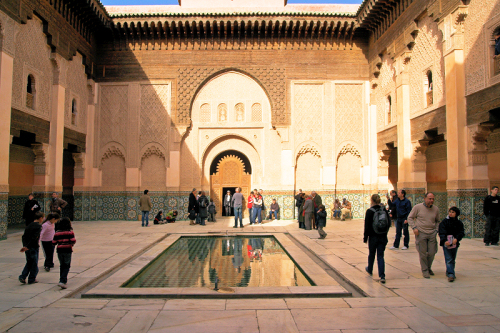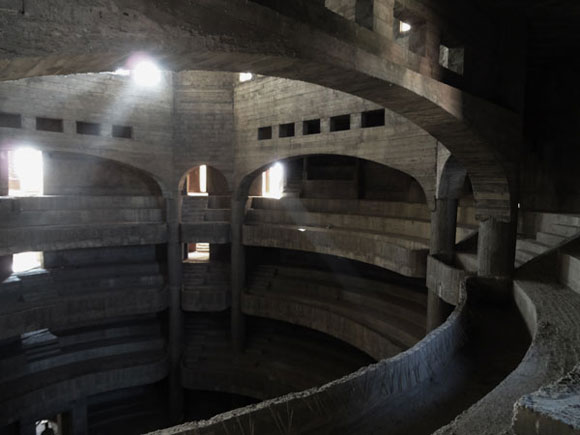48 hours In: Marrakech

Temperatures in Marrakech are warming up, with highs of around 18°C. Next week the city hosts the Marrakech Biennale (February 29-March 4). A celebration of arts, literature and debate, it attracts both a local and an international line-up — this year's film panel is curated by Alan Yentob (marrakechbiennale.org).
Touch down
Marrakech's Menara airport is served by BA (tel: 0844 493 0787; ba.com) and BMI (tel: 0844 848 4888; flybmi.com) from Heathrow; easyJet (tel: 0843 104 5000; easyJet.com) and Thomson (tel: 0871 231 4787; flights.thomson. co.uk) from Gatwick and Manchester and Ryanair (tel: 0871 246 0000; ryanair. com) from Luton and Stansted.
The medina (the ancient walled city centre) is a 15-minute drive from the airport. There are two types of taxis: petit taxis and the larger grand taxis (usually old Mercedes). The former have meters but these are rarely used, so agree a price before you set off: between 70 dirham (£5.30) and 100 dirham (£7.50). Bus 19 departs from the airport every hour and costs 20 dirham (£1.50); it stops at several points in the centre including Djemaa el Fna and the Place du 16 Novembre.
Get your bearings
Known as the Rose City, owing to the deep pink hue of its medina walls, Marrakech is spectacularly bordered by the Atlas Mountains to the south and the Jbilets hills to the north. The Unesco-listed medina is the star attraction. A heady mosaic of alleyways, houses, souks and workshops, it is dominated by the towering Koutoubia Mosque. West of the medina is the Ville Nouvelle — laid out in the early 20th century during the French Protectorate. Most visitors will find themselves in its Hivernage and Guéliz neighbourhoods, which are home to hotels, shops and restaurants. The latter is also home to the tourist office at Place Abdel Moumen Ben Ali/Avenue Mohammed V (tel: 00 212 524 43 61 31; marrakech. travel). It opens Monday-Friday 8.30am-4.30pm.
North-east of the city is the sprawling Palmeraie, dotted with over 100,000 palm trees planted by the Almoravids in the 12th century. These days, it is also home to lavish resorts and golf courses.
Check in
Winston Churchill loved to paint in the tranquil orange tree-dotted gardens of La Mamounia (tel: 00 212 524 388600; mamounia.com). Set just inside the medina, this Art Deco landmark is still one of its most glamorous addresses, thanks to a recent renovation at the hands of French designer Jacques Garcia. Doubles start at 6,050 dirham (£500), room only.
Riads are another highlight — there are hundreds of these courtyard houses in the medina. One of the most charming is Riad Madani (tel: 00 212 524 441884; riad-madani.com). Its antique scattered rooms start at €110 including breakfast; there's also a pool.
Set outside town with views of the mountains, the Beldi Country Club (tel: 00 212 524 383950; beldicountryclub.com) in Cherifia is a rustic-chic, rose-filled estate with a 27-room hotel built in the style of a small traditional Moroccan village. There are also two restaurants, a pool, spa and three boutiques selling the work of on-site artisans and stylish antiques. Doubles from €170, including breakfast.
Take a view
For many, the Djemaa el Fna, encapsulates all that is exotic about the city. From dawn until well after dusk, this central square buzzes with snake charmers, tooth pullers, magicians, henna artists and storytellers. A rite of passage for any visitor is the Café de France(tel: 00 212 524 442319), which also has one of the best vantage points of the square. Sip a mint tea (15 dirham/£1.10) and soak it all up.
Take a hike
Start in the gardens of the Koutoubia Mosque. Its 77m-tall minaret is one of most impressive in the region. Cross Place Youssef Ben Tachfine and continue down the rue Sidi Mimoune. You will soon reach one of the medina's most impressive gates, the highly decorative Bab Agnaou. Nearby is the Kasbah Mosque, with its turquoise minaret. Behind a high wall next door are the Saadian Tombs. Open daily 8.30-11.45am, 2.30-5.30pm; 10 dirham (75p). The tombs of over 60 members of the Saadian dynasty are intricately decorated with zellige mosaics and carved alabaster and marble.
Outside, plunge into the tiny streets of the Kasbah quarter, until you arrive via the Bab Berrima at the impressive remains of the Palais El Badi. The erstwhile palace of Sultan Ahmed el-Mansour, the remnants hint at its former splendour. Go back to the Place des Ferblantiers and continue along the rue Bahia Bab Mellah, which skirts the tightly packed lanes of the former Jewish ghetto.
You will soon arrive at the Palais Bahia. This late 19th-century palace is resplendent with stunning rooms, courtyards, fountains and verdant gardens. Turn up the rue Riad Ezitoune El Jadid, lined with 19th-century palaces, eventually bearing left until you arrive at Djemaa el Fna.


Lunch on the run
The Souk Quessabine is a tiny lane running off the northwestern corner of Djemaa el Fna. Here, a row of half a dozen stalls sell méchoui, lamb roasted in an underground clay pit. For about 20 dirham (£1.50) you can have a delicious sandwich (Jamie Oliver approved).
Window shopping
You will definitely get lost in the tangle of the souks, but that's all part of the fun of a shopping trip here. Start on rue El Mouassine and plunge into the sinuous alleyways that peel off it, crammed with stalls. Each souk is loosely grouped by what it sells: babouches (leather slippers), herbs, carpets, ironmongery, woodcarving and so on. The Souk des Teinturiers or dyers' souk offers good photo opportunities. They open until late at night, but lunchtimes tend to be quieter. If haggling fatigue sets in, seek out the anonymous door at 142-144 Bab Doukkala (tel: 00 212 524 38 52 40), the emporium of Mustapha Blaoui. Here you can sip mint tea and browse a succession of rooms housing lanterns, pottery, leather and more.
An aperitif
Built in 1925, the Grand Café de la Poste (tel: 00 212 524 43 30 38; grandcafe|delaposte.com) on the corner of Boulevard el-Mansour Eddahbi and Avenue Imam Malik is a former post office restored to its colonial splendour as a café. Order a glass of quaffable local Moroccan wine for 50 dirham (£3.75).
Dining with the locals
Al Fassia Aguedal, 9 bis route de l'Ourika (tel: 00 212 524 43 4060; alfassia. com), is known for its Fez-inspired cuisine — tagine, couscous and pigeon pastilla — made by female chefs. A three-course meal costs around 530 dirham (£40), with wine.
Out to brunch
Le Jardin, 32 souk El Jeld Sidi Abdelaziz (tel: 00 212 524 37 82 95; lejardin.ma) is a new addition to the souks, set in a 17th-century riad done out in a vaguely Sixties style. Sunday brunch (11am-3pm) costs 90 dirham (£6.75) — tuck into date and banana smoothie or orange juice, coffee, tea and Moroccan pancakes served with amlou (argan oil, honey and almond paste) that's a deluxe version of peanut butter.
Take a ride
It may be touristy, but a horse-drawn calèche is one of the best ways to tour inside the 11th-century city walls. They congregate around the edge of Djemaa el Fna near Bab el Jdid and there is now a fixed price of 150 dirham (£11.20) per hour. A circuit will take about two hours.
Cultural afternoon
Dating from the 16th century, the Ben Youssef Medersa (00 212 52 44 418 93; musee.ma) is one of the city's greatest Islamic monuments and used to be the largest university of theology in Maghreb. Inside, its rooms and arcades display striking zellige mosaics, delicately carved cedarwood screens and stucco, set around a courtyard. Admission (60 dirham/ £4.50) also includes entry to the adjacent Musée de Marrakech with exhibitions of ethnographic and Islamic objects. Both open daily, 9am-6.30pm.
A walk in the park
With its green displays of bamboo, cacti and myriad plant species and architecture painted in the cobalt hue known as Majorelle blue, the tranquil Jardin Majorelle, Avenue Yacoub El Mansour (tel: 00 212 5 24 31 30 47; jardinmajorelle.com) is a must-see. Begun in the 1920s by the French painter Jacques Majorelle, the garden was later acquired by the fashion designer Yves Saint Laurent. Open daily 8am- 5.30pm; 40 dirham (£3).
The icing on the cake
A hammam is the ultimate steam bath and exfoliation. Les Bains de Marrakech, 2 Derb Sedra, Bab Agnaou (tel: 00 212 524 381 428; lesbainsdemarrakech.com; daily 9am-8pm) fulfils all Arabian Nights fantasies; hammams from 150 dirham (£11.20). Or indulge at the opulent Royal Mansour hotel, rue Abou Abbas El Sebti (tel: 00 212 529 80 82 00; royalmansour.com) for 1,200 dirham (£90).
morocco culture,moroccan food,morocco food,moroccan cuisine,morocco beaches,moroccan meal,beaches in morocco,moroccan culture,hercules cave,hercules cave morocco




















